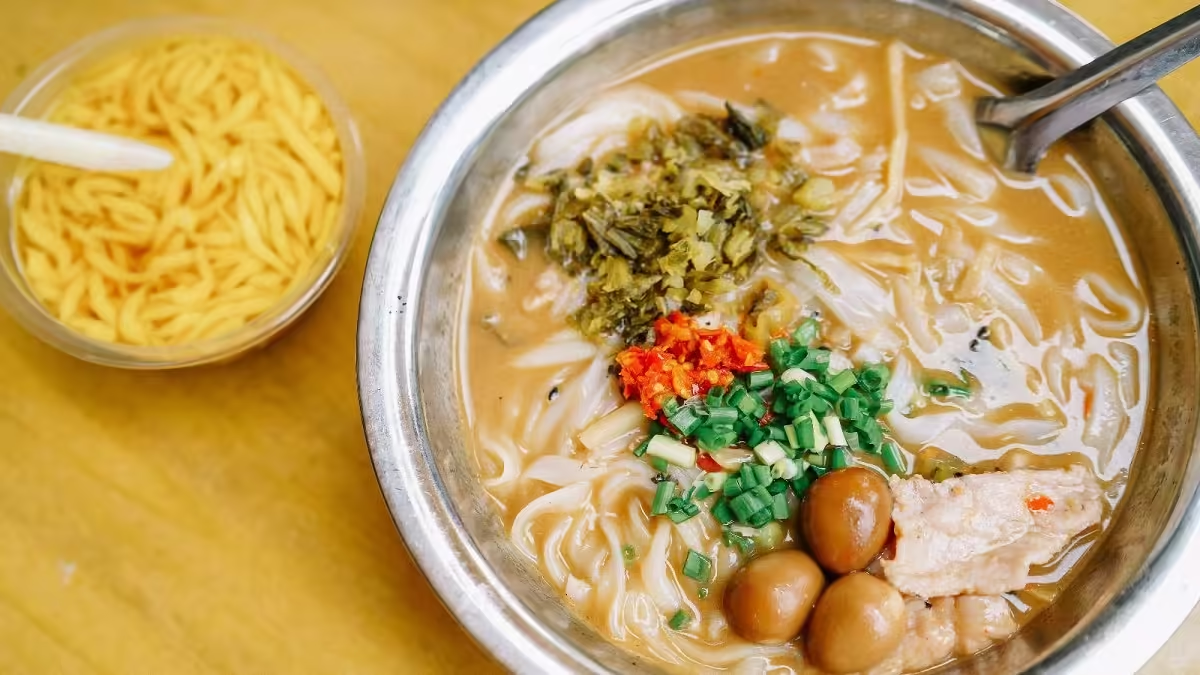Nanning Laoyou Rice Noodles (南宁老友粉, Nanning Old Friends Rice Noodles) are a flavorful and iconic dish from Nanning, Guangxi, with a history steeped in local legend. Originating from the older “Laoyou Noodles,” this dish earned its name through tales of friendship and care, showcasing a unique blend of ingredients and rich culinary traditions.
The Origin Story of Laoyou Rice Noodles
Two popular legends explain the origins of this dish:
- The Tea House Friends: In the early 20th century, a group of friends frequently gathered at a tea house in the city center of Nanning. One day, one of the friends fell seriously ill and was unable to join them. The tea house owner, known for his culinary skills, prepared a special noodle dish to help the sick friend recover. This dish, with its invigorating flavors and nourishing qualities, restored the friend’s appetite and health. In gratitude, the friend gifted a plaque inscribed with the words “Old Friends Always Welcome” (老友常来). Over time, the noodle dish became famous across Guangxi and even internationally, earning the name “Laoyou Noodles.”
- The Caring Elderly Customer: In the 1930s, an elderly man was a daily visitor to a tea house owned by a family surnamed Zhou. When he stopped coming for a few days due to illness, the tea house owner, worried about his loyal patron, prepared a bowl of noodles. The dish featured sautéed garlic, fermented black beans, pickled bamboo shoots, chili peppers, ground beef, and a touch of white pepper. Delivered to the elderly man’s home, the hot, tangy, and aromatic noodles not only revitalized his appetite but also alleviated his cold symptoms. Deeply moved, the elderly man gifted a plaque with the words “Old Friends Always Visit” (老友常临). Initially known as “Laoyou Noodles,” the dish later evolved to incorporate rice noodles, becoming the beloved “Laoyou Rice Noodles.”
The Art of Making Laoyou Rice Noodles
The preparation of Laoyou Rice Noodles is a meticulous process, combining traditional techniques and modern adaptations.
Traditional Noodles: Originally, the dish used wheat-based noodles made by kneading dough with eggs, rolling it into thin sheets, and cutting it into fine strips. Alternatively, wet flat rice noodles or sliced rice noodles were used.
Modern Techniques: Today, the focus is on rice noodles, crafted through a multi-step process:
- Fermentation: High-quality rice is washed and sealed in a container to ferment. Every two days, it is rinsed and resealed, repeating the process for about 5–6 days until fermentation is complete.
- Grinding: The fermented rice is finely ground into a smooth paste, ensuring no granular texture remains.
- Shaping: The rice paste is either pressed through molds into boiling water to create noodle strands or spread flat, steamed for half an hour, cooled, and cut into strips.
- Cooking: The noodles are cooked with a fragrant mixture of sautéed garlic, fermented black beans, pickled bamboo shoots, chili, pork, or beef, creating the final dish.
Ingredients: Key ingredients include:
- Rice noodles: Often flat, rectangular strips or wet rice noodles.
- Fermented black beans (dou chi): For their salty, umami flavor.
- Garlic and ginger: Aromatic staples that enhance the dish.
- Pickled bamboo shoots: For a tangy, distinctive taste.
- Meat: Typically pork, beef, or pork liver, adding richness to the dish.
- Chilies: Fresh or in sauce form, providing heat.
Flavor and Texture
Laoyou Rice Noodles are renowned for their bold and layered flavors, complemented by a hearty texture that makes every bite memorable.
1. The Broth: The soul of Laoyou Rice Noodles lies in its tangy, savory, and spicy broth. The sourness from pickled bamboo shoots blends with the salty umami of fermented black beans and the heat of chilies, creating a rich and complex base.
2. The Noodles: The flat, rectangular rice noodles are cooked to perfection. They are tender yet chewy, with a smooth texture that absorbs the flavors of the broth beautifully. Unlike softer noodles, they retain their structure, offering a satisfying bite.
3. The Meat and Toppings: Meats like pork or beef are marinated and cooked with precision, remaining tender and juicy. These proteins add depth and balance to the dish, blending seamlessly with the noodles and broth.


